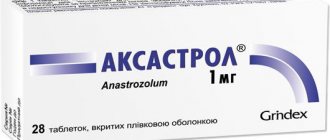Pharmacological properties of the drug Xefocam Rapid
Lornoxicam is an NSAID with analgesic and anti-inflammatory effects, belongs to the oxicam class. The mechanism of action of lornoxicam is based in part on the inhibition of prostaglandin synthesis (COX inhibition). Inhibition of COX does not increase the formation of leukotrienes. The analgesic effect of lornoxicam is not associated with narcotic effects. The drug Xefocam Rapid does not have an opioid-like effect on the central nervous system and, unlike narcotic analgesics, does not depress respiration and does not cause the development of drug dependence. Lornoxicam is quickly and almost completely absorbed from the gastrointestinal tract. The maximum concentration in blood plasma is achieved 30 minutes after taking the drug. The maximum concentration of the drug Xefocam Rapid is higher than the maximum concentration of the drug Xefocam tablets, and is equivalent to the maximum concentration for dosage forms of lornoxicam for parenteral administration. The absolute bioavailability (calculated by AUC) of Xefocam Rapid tablets is 90–100% and is equivalent to the bioavailability of Xefocam tablets. The drug has no first pass effect. The average half-life is 3–4 hours. In blood plasma, lornoxicam is present unchanged and in the form of its hydroxylated metabolite, which does not have pharmacological activity. The binding of lornoxicam to plasma proteins is 99% and does not depend on its concentration. Lornoxicam is completely metabolized; about 2/3 liters of ornoxicam are excreted through the liver and 1/3 through the kidneys in the form of an inactive compound. Lornoxicam (like diclofenac and other oxicams) is metabolized by cytochrome P450 2C9. As a result of genetic polymorphism, there are individuals with slow and intensive metabolism, which is reflected in a marked increase in plasma levels of lornoxicam in individuals with slow metabolism. In animal model studies, lornoxicam did not induce liver enzymes. Based on the results of clinical trials, there is no data on the accumulation of lornoxicam after repeated doses of recommended doses. Data from studies on the use of the drug Xefocam Rapid tablets showed that taking lornoxicam with food reduced the maximum concentration of the drug to 30%, the time to reach the maximum concentration increased from 1.5 to 2.3 hours. The absorption of lornoxicam (calculated by AUC) may decrease by up to 20% . Concomitant use with antacids does not affect the pharmacokinetics of lornoxicam. In patients with impaired liver or kidney function, no significant changes in the pharmacokinetics of lornoxicam were detected.
Stock
dyucha speech:
lornoxicam;
1 tablet of 8 mg lornoxicam;
additional speeches:
calcium stearate, hydroxypropylcellulose, sodium hydrogencarbonate, low-substituted hydroxypropylcellulose, microcrystalline cellulose, calcium hydrogenphosphate;
spit shell
: propylene glycol, talc, titanium dioxide (E 171), hypromelose.
Medicine form.
Tablets, coated with spit coating.
Main physical and chemical authorities:
round, biconvex tablet, covered with a spit coating, white to light yellow color.
Contraindications to the use of the drug Xefocam Rapid
Hypersensitivity to lornoxicam or other components of the drug; hypersensitivity to other NSAIDs, including acetylsalicylic acid (asthma-like symptoms, rhinitis, angioedema or urticarial rash); gastrointestinal bleeding, bleeding from cerebral vessels or other hematological disorders; active peptic ulcer of the stomach or duodenum or a history of recurrent peptic ulcers; severe renal failure (serum creatinine level 700 µmol/l); severe thrombocytopenia; severe heart failure; During pregnancy and breastfeeding; age up to 18 years.
Side effects of the drug Xefocam Rapid
About 16% of patients (with long-term treatment - 20–25%) may experience adverse reactions from the gastrointestinal tract; in 5% - reactions associated with general disorders and/or disorders of the central nervous system and in 2% of cases - skin reactions. Side effects are common to all NSAIDs and other antirheumatic drugs, namely:
- gastrointestinal ulcers with the development of intestinal perforation, sometimes severe;
- duodenal ulcer, vomiting with blood, melena;
- development of severe skin reactions and life-threatening hypersensitivity reactions;
- rarely - interstitial nephritis, glomerulonephritis, tubular necrosis of the kidneys or nephrotic syndrome;
- pathological changes in the peripheral blood picture, leukopenia.
When taking Xefocam Rapid tablets, the following side effects may occur. From the gastrointestinal tract: often (1% and ≤10%): abdominal pain, diarrhea, dyspepsia, nausea, vomiting; rarely (≤1%): constipation, dysphagia, flatulence, dry mouth, gastritis, gastroesophageal reflux, peptic ulcer and/or gastrointestinal bleeding, stomatitis, hemorrhoidal bleeding. General: often : dizziness, headache; rarely: sleep disturbance, drowsiness, malaise, weakness, hot flashes. From the skin and subcutaneous tissue: rarely: alopecia, dermatitis, itching, increased sweating, urticarial rash, purpura, ecchymosis. From the hematopoietic system: abnormal blood count, pathological changes in the peripheral blood picture, leukocytopenia; rarely: thrombocytopenia, increased bleeding time, anemia, decreased number of red blood cells, hemoglobin and leukocytes. From the cardiovascular system: rarely: pulmonary edema, hypertension, palpitations, tachycardia, hypotension. Neurological disorders: rarely: drowsiness, dizziness, vertigo, paresthesia, tremor, taste disturbance. Respiratory disorders: rarely: shortness of breath, bronchospasm, cough, rhinitis. From the kidneys and urinary system: rarely: increased levels of urea nitrogen and creatinine in the blood serum, impaired urine outflow. From the side of the central nervous system: rarely: agitation or depression. From the hepatobiliary system: increased levels of liver transminases, alkaline phosphatase; rarely: liver dysfunction. From the musculoskeletal tissue: rarely: myalgia, limb cramps. From the organs of vision: rarely: conjunctivitis, visual impairment. From the hearing organs: rarely: ringing in the ears. From the immune system: rarely: allergic reactions. From the side of metabolism and nutrition: rarely: loss of appetite, change in body weight.
Side effects
The most common adverse reactions of NSAIDs were associated with the scolio-intestinal tract. When taking NPZZ, peptic infections, perforation or intestinal hemorrhage may occur, which can sometimes end in death, especially in the summer (section “Peculiarities of Stagnation”). Nausea, vomiting, diarrhea, flatulence, constipation, dyspepsia, abdominal pain, melena, vomiting with blood, virulent stomatitis, acute colitis and Crohn's disease were registered during the treatment of the NPZZ (divisional section “Peculiarities for stosuvannya"). We used to be careful about gastritis.
It is important that approximately 20% of patients who were treated with lornoxicam may experience side effects. The most common side effects of lornoxicam are fatigue, dyspepsia, eating disorders, abdominal pain, vomiting, and diarrhea. These symptoms were less common in 10% of patients who participated in the investigations.
The incidence of swelling, arterial hypertension, and heart failure as a result of stagnation of NPDD was recorded.
Clinical studies and epidemiological data suggest that the use of certain NSAIDs, especially at high doses and during trival administration, may be associated with an increased risk of arterial thrombotic complication, for example, myocardial infarction or stroke (section “Peculiarities of congestion”).
Vinyatkovo was once sick with chickenpox and was reported to have serious infectious problems on the side of the skin and soft tissues.
The incidence of adverse reactions, which were observed in more than 0.05% of 6417 patients who were treated with the drug during phases II, III and IV clinical follow-up, was less likely to occur.
Unusual effects that may occur when taking the drug Xefocam Rapid are classified according to frequency into the following categories: very often (> 1/10), often (> 1/100 - < 1/10), infrequently (> 1/1000 - < 1/100), rarely (> 1/10000 ‒ < 1/1000), very rarely (<1/10000), unknown (frequency cannot be estimated based on obvious data).
Infections and invasions.
Rarely: pharyngitis.
On the side of the blood and lymphatic system.
Rarely: anemia, thrombocytopenia, eosinophilia, leukopenia, coagulation disorders, increased bleeding, pancytopenia.
Very rarely: ecchymosis. NSAIDs often cause potentially severe hematological disorders characteristic of this class, such as neutropenia, agranulocytosis, aplastic and hemolytic anemia.
On the side of the immune system.
Rarely: hypersensitivity reactions, fever, chills, anaphylactoid reactions, anaphylaxis.
I’ll exchange speeches on the side.
Uncommon: loss of appetite, change body mass.
Metabolism and ruined food.
Rarely: hyponatremia.
Mental disorders.
Uncommon: insomnia, depression.
Rarely: confusion of information, restlessness, increased restlessness, loss of concentration, changes in self-esteem, cognitive disorders.
On the side of the nervous system.
Often: mild short-term headache, confusion.
Rarely: drowsiness, paresthesia, dysgeusia, tremor, migraine, hyperkinesia, hypoesthesia.
Very rare: aseptic meningitis in patients with systemic worms and mixed diseases of contaminated tissue (section “Peculiarities of congestion”).
From the side of the organs.
Uncommon: conjunctivitis.
Rarely: impaired vision, including blurred vision, impaired color perception, visual field defects, amblyopia, diplopia; scotoma, iridocyclitis.
Behind the organs of hearing and the labyrinth of the ear.
Uncommon: vertigo, ringing in the ears.
On the side of the cardiovascular system.
Uncommon: palpitations, tachycardia, swelling, blackout, heart failure, diarrhea.
Rarely: arterial hypertension, hot flashes, hemorrhage, vasculitis, hematomas.
On the side of the respiratory system, the organs of the chest and the mediastinum.
Uncommon: rhinitis.
Rarely: dyspnea, cough, bronchospasm.
On the side of the grass tract.
Common: boredom, abdominal pain, dyspepsia, diarrhea, vomiting.
Uncommon: constipation, flatulence, vomiting, dry mouth, gastritis, vulcanis and duodenum, pain in the upper abdomen, clear bleeding, virulent stomatitis.
Rarely: melena, vomiting with blood, stomatitis, esophagitis, gastroesophageal reflux disease, dysphagia, aphthous stomatitis, glossitis, perforation of peptic ulcers, hemorrhoids, intestinal bleeding.
On the side of the hepatobiliary system.
Uncommon: increased levels of liver enzymes (ALT, AST).
Very rarely: toxic effect on the liver, resulting in possible development of liver failure, hepatitis, hepatitis, cholestasis.
On the side of the skin and under the skin.
Uncommon: irritation, itching, increased sweating, erythematous irritation, urticaria and angioedema, alopecia.
Rarely: dermatitis, eczema, maculopapular rash, purpura.
Very rarely: swelling and bullous reactions, nail changes, psoriasis, erythema multiforme, Stevens-Johnson syndrome, toxic epidermal necrosis.
On the side of the bone-muscle system and tissue.
Uncommon: arthralgia.
Rarely: pain in the wrists and back, muscle cramps, muscle weakness, myalgia, synovitis.
On the side there is a sternoid system.
Rarely: nocturia, impaired sperm production, increased levels of blood nitrogen and creatinine in the blood.
Very rarely: lornoxics can cause acute nitric deficiency in patients with already obvious illnesses of nirc, as they lie on the nirc prostaglandins, which play an important role in supporting nirc blood flow (division " Features of zastosuvannya"). Nephrotoxicity in various forms, including nephritis and nephrotic syndrome, is a characteristic effect of NSAIDs. Є development of papillary necrosis caused by the use of NSAIDs.
The backyard is destroyed.
Infrequently: unwell, exposed.
Rarely: asthenia.
Special instructions for the use of the drug Xefocam Rapid
Xefocam Rapid should not be prescribed to children and adolescents under the age of 18 years. There is no need for dose adjustment in elderly patients. If liver or kidney function is impaired, the daily dose should be reduced. History of gastrointestinal ulcers and bleeding. In the process, periodic monitoring of the patient is necessary. If a patient develops a peptic ulcer and/or gastrointestinal bleeding while taking Xefocam Rapid, the drug should be discontinued and appropriate therapeutic measures should be taken. Renal failure Patients with mild renal failure (serum creatinine 150–300 μmol/L) should be monitored quarterly; with moderate renal failure (serum creatinine 300-700 µmol/l) - should be examined at intervals of 1-2 months. If renal function deteriorates, treatment with Xefocam Rapid should be discontinued. Patients with bleeding disorders A thorough clinical examination and evaluation of laboratory parameters (for example, prothrombin time) are recommended. Long-term treatment (more than 3 months) Regular assessment of blood condition (hemoglobin level), kidney function (creatinine level) and liver function (liver enzyme level) is recommended. For elderly patients (65 years and older), patients weighing less than 50 kg, as well as patients undergoing surgery, monitoring of liver and kidney function is recommended. It is necessary to monitor renal function in patients: who have undergone major surgery; in conditions leading to acute impairment of kidney function, for example as a result of significant blood loss or severe dehydration; patients with signs of heart failure who are simultaneously treated with diuretics, as well as drugs that lead to kidney damage. Use during pregnancy and lactation The safety of Xefocam Rapid during this period has not been established, therefore it should be prescribed only after a careful assessment of the expected benefits of therapy for the mother and the possible risk to the fetus. Stop breastfeeding for the period of treatment. Patients taking the drug should refrain from activities that require increased attention and rapid motor reactions, driving vehicles and operating machinery. Alcohol consumption is contraindicated.
Interactions of the drug Xefocam Rapid
Interactions observed when taking Xefocam Rapid together with the following medications:
- anticoagulants or platelet aggregation inhibitors - may increase bleeding time (increased risk of bleeding); the risk of spinal/epidural hematoma increases with spinal or epidural anesthesia;
- sulfonylurea derivatives: the hypoglycemic effect of the latter may be enhanced;
- other NSAIDs: increased risk of side effects;
- diuretics: the effectiveness of loop diuretics is reduced;
- ACE inhibitors: may reduce the effect of ACE inhibitors;
- Lithium preparations: may cause an increase in maximum lithium concentrations and, as a result, an increase in side effects associated with lithium intake;
- methotrexate and cyclosporine: increases the concentration of methotrexate and cyclosporine in the blood serum;
- cimetidine: increases the level of lornoxicam in the blood plasma;
- digoxin: reduces the renal clearance of digoxin.
No interaction has been identified between Xefocam Rapid and ranitidine or antacids. Lornoxicam interacts with known inducers and inhibitors of CYP 2C9 isoenzymes (for example, rifampicin).
Overdose of the drug Xefocam Rapid, symptoms and treatment
The following symptoms may be noted: nausea, vomiting, central nervous system symptoms (dizziness, ataxia, convulsions, up to the development of coma). Possible changes in liver and kidney function, blood clotting disorders. In case of real or suspected overdose, you should stop taking the drug. Due to its short half-life, lornoxicam is quickly eliminated from the body; dialysis is not effective. A specific antidote is not known. It is necessary to provide for the usual emergency measures, including gastric lavage; activated carbon is effective only if it is taken immediately after a high dose of Xefocam Rapid. Treatment is symptomatic.
Overdose
At this time, there is no need to overdose with the drug, which would allow you to determine your results or apply a specific treatment. If you overdose with lornoxicam, you may experience the following symptoms: nausea, vomiting, cerebral symptoms (confusion, blurred vision). In severe cases: ataxia, with transition from coma to trial; liver and liver problems; Possible loss of blood throat.
In case of real or overdose, the drug must be stagnated. After a short period of administration, lornoxics are quickly eliminated from the body. Not amenable to dialysis. At the moment there is no specific antidote. It is necessary to carry out initial, unscheduled visits, including washing the spool. Based on fundamental principles, only the use of active vugill for the purpose of washing one’s body immediately after an overdose of lornoxicam can change the dosage of the drug. For the treatment of bowel-intestinal disorders, you can, for example, use a prostaglandin analogue or ranitidine.


